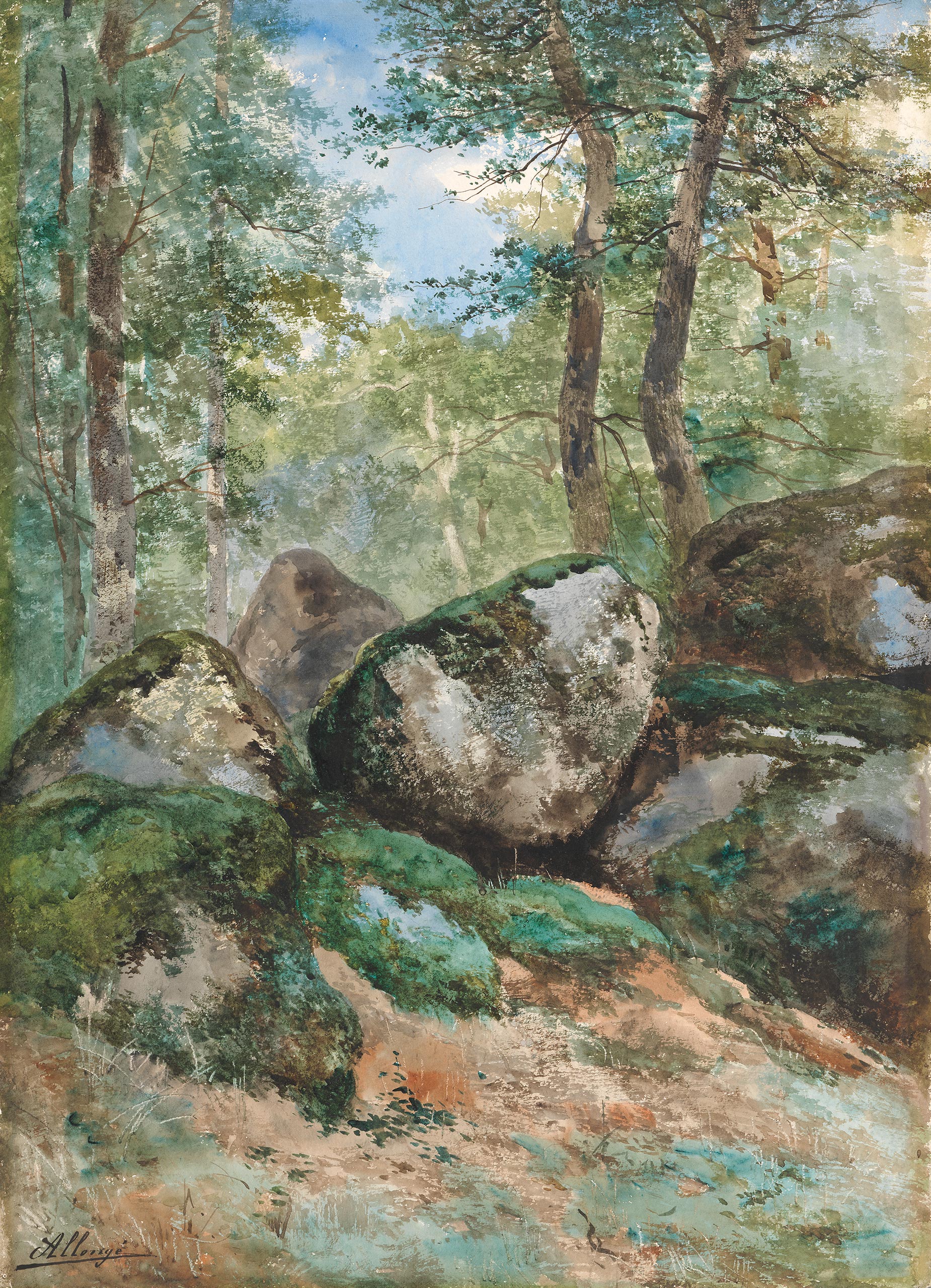
Allongé
Auguste
Paris 1833 — Bourron Marlotte 1898
View of the Fontainebleau Forest
Watercolour and gouache over graphite.
Signed Allongé lower left.
785 x 560 mm (30 15⁄16 x 22 1⁄16 in.)
“The beloved author of a number of exquisite works, with a singularly personal accent, and a truth of impression that strikes even the indifferent, Auguste Allongé is one of those artists now in the public eye, whose drawings are as prized as the paintings of the most undisputed masters of landscape painting: he too is a master!” commented journalist and novelist Louis Enault,1 a close friend of Gustave Doré, in 1881, on the prolific landscape painter and one of the most emblematic artists of the Forest of Fontainebleau.
A pupil of Léon Cogniet at the École Impériale des Beaux-Arts, and also of Louis-Joseph Ducornet, Allongé quickly turned away from history painting to specialize in landscapes. He was initially interested in charcoal, on which he wrote a treatise in 1873. He liked to work on tonal values more than colours, to the point that Louis Enault wrote in 1882 that he was, along with Maxime Lalanne, one of the “kings of charcoal”.2 His coloured landscapes, oils on canvas and watercolours were nevertheless hugely successful during his lifetime and continue to fascinate. He quickly acquired an extraordinary mastery of watercolour. His works in this technique met with great success and remain highly appreciated today, for their realism that is both photographic and poetic, their bright, joyful colours, and their admirable sense of living nature, as demonstrated by this unusually large view with its spectacular freshness.
An emblematic artist of the Forest of Fontainebleau, Allongé regularly painted in the vicinity of Marlotte, where communities of artists seeking affordable accommodation close to the forest had settled since the Second Restoration. What Gérald Schur has called “the Marlotte group” brought together the first painters who wanted to paint in the heart of the forest of Fontainebleau, in a place protected from the wind, with cheaper lodging and a friendly atmosphere. They included Alexandre Louis Barye, Jacques Raymond Brascassat, Théodore Caruelle d’Aligny, Jean-Baptiste Corot, Alexandre Gabriel Descamps, Narcisse Diaz de la Pena, Paul Huet, Achille Etna Michallon and Théodore Rousseau.
From the 1860s onwards, Sisley, Renoir, Monet, Cézanne, Pissarro, Bazille and others would gather in Marlotte, at the two famous inns of the village: the Auberge Saccault and the Auberge de la Mère Antony. Parisian writers also liked to stay here, following in the footsteps of Henry Murger, the author of Scènes de la vie de bohème. Théophile Gautier, Alfred and Paul de Musset and Théodore de Bainville were regular visitors to Marlotte. It was at Antony’s Inn that Zola wrote L’Assommoir. In the wake of these famous artists and writers, lesser-known but much-appreciated landscape artists such as Auguste Allongé, Eugène Ciceri and Armand Point settled here. Auguste Allongé, whose main studio was in Paris, not only painted in Marlotte, but also travelled all over France painting his landscapes.
An extremely prolific draughtsman, Allongé left a substantial body of graphic work. This watercolour, which stands out for its exceptionally large size, the freshness of its colours and the spontaneity of its composition, is the best testimony ever to its creator’s talent
- L. Enault, Paris-Salon 1881, Paris, E. Bernard et Cie, 1881.
- L. Enault, Paris-Salon 1882, Paris, E. Bernard et Cie p.13.

